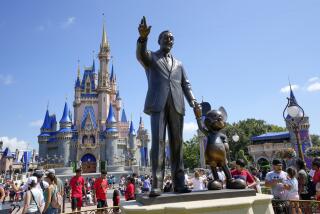A Bold Bit of Disney Image-ineering Pays Off
- Share via
The mouse is roaring again on Wall Street.
Troubled by its faltering image with investors after a series of setbacks last year, Walt Disney Co. invited nearly 200 analysts and money managers to Los Angeles late last week to hear a powerful message: Don’t underestimate this $11-billion company’s potential.
Disney’s bold presentation, punctuated by a surprisingly strong fourth-quarter earnings report issued late Thursday, had the desired effect. The company’s stock soared $3 to an all-time high of $50.25 on Friday in heavy trading.
“Disney has finally got its momentum back,” said an exuberant Jessica Reif, analyst at Merrill Lynch & Co.
Lou Abel, analyst at money manager Roger Engemann & Associates in Pasadena, said the meeting stoked his belief in the “fantastic franchise” Disney has.
Most important for investors, Disney Chairman Michael Eisner and his division chiefs reaffirmed their commitment to maintaining the company’s historic annual earnings growth rate of 20%--a number that has magic connotations on Wall Street, so starved for true growth stocks.
Jeffrey Logsdon, analyst at the Seidler Cos. in Los Angeles, said Eisner’s basic theme was that “ ‘I’m not going to be the guy who breaks that (growth) streak.’ If they can’t grow the business enough, they’ll cut costs or buy back stock and get (20% growth) that way.”
For the quarter ended Dec. 31, Disney far exceeded the 20% target, as earnings shot up 31% from a year earlier, to $482 million. Per-share results were up 34% to 91 cents, versus analysts’ consensus estimate of 78 cents.
What analysts most wanted to see in the quarterly report--and hear at the management meeting--was that Disney’s theme-park division was turning up after a weak spring and summer and continued bad news out of the company’s 39%-owned Euro Disney park near Paris.
And indeed Disney said the park picture has improved significantly. Revenue rose 11% in the latest quarter, and operating income jumped 21%. Logsdon said Disney execs confirmed that attendance is up at the parks, helped in part by foreign tourists’ return to Walt Disney World in Florida as memories of the state’s much-publicized rash of tourist murders have receded.
Disney also has put the parks on a diet of sorts and expects to save $100 million this year from cost-cutting.
Even though movies have become Disney’s chief engine for growth in recent years--contributing more than half of sales and earnings--the company’s theme-park troubles last year (especially Euro-Disney’s poor attendance) came to be viewed as emblematic of a “new” Disney, a once-stellar growth firm that had lost its way.
That perception was enhanced by a long list of missteps and misfortunes: the Virginia theme park proposal that was greeted by a barrage of public criticism; the death of Disney President Frank Wells; Eisner’s quadruple bypass surgery, and the departure of studio chief Jeffrey Katzenberg.
Just three months ago, Disney stock was languishing at $38, and nothing Eisner said about the future seemed to carry much weight.
*
So why Wall Street’s sudden change of heart? In part, proof of Disney’s renewed momentum had to show up in its quarterly numbers, and did last week.
But analysts and investors who met with the company last Thursday and Friday--in the biggest such Wall Street gathering sponsored by Disney in several years--said the company’s executives appear to be infused with a new aggressiveness and a fresh desire to prove how much earnings potential remains in all Disney assets.
In a session lasting five hours last Thursday, Disney executives figuratively walked analysts and investors through every division, detailing growth prospects for each, Merrill’s Reif said.
Much of what the attendees heard wasn’t new: plans for more hotel rooms at Disney World, for example; more animated feature films (“Pocahontas” is next) and continued “product-line extensions” such as stage shows based on Disney movies ( a la “Beauty and the Beast”).
Wall Street’s enthusiastic reaction, however, seemed to indicate that Eisner got his central message across: Despite the loss of Wells and Katzenberg, there is no problem with management depth, nor any shortage of opportunities to expand sales and earnings.
Although some analysts last year criticized Eisner for failing to bid for a TV network--the argument was that Disney needed a “bold” move to leverage its presence in entertainment--Eisner’s reluctance to make such a high-risk bet may now be gaining converts.
Indeed, Eisner stressed last week that he won’t make dilutive acquisitions. “He said he isn’t going to make Larry Tisch or Jack Welch rich,” said Seidler’s Logsdon, referring to the heads of CBS and NBC parent General Electric.
Instead, in recommitting to 20% earnings growth, Eisner seems focused on enriching his own shareholders (himself included), either through internal expansion or stock buybacks or a combination thereof. In the fourth quarter alone, Disney bought back 12.4 million shares for $512 million. But at a record $50.25 now, is the stock cheap or expensive? Many analysts on Friday raised their 1995 earnings estimate to about $2.65 a share, which gives the stock a price-to-earnings ratio of about 19. In a market where investors are scrambling out of industrial stocks and into consumer growth issues--sensing a slowing economy--Merrill’s Reif believes Disney deserves a bigger premium. Her 12-to-18-month price target: $70.
More to Read
Inside the business of entertainment
The Wide Shot brings you news, analysis and insights on everything from streaming wars to production — and what it all means for the future.
You may occasionally receive promotional content from the Los Angeles Times.










